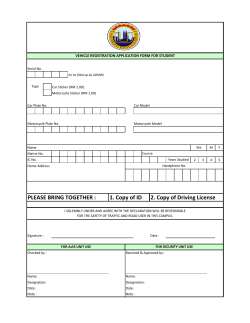
Africa-Arabia-Eurasia plate interactions and
This page added by the GeoPRISMS office. Africa-Arabia-Eurasia plate interactions and implications for the dynamics of Mediterranean subduction and Red Sea rifting Authors: R. Reilinger, B. Hager, L. Royden, C. Burchfiel, R. Van der Hilst Department of Earth, Atmospheric, and Planetary Sciences, Massachusetts Institute of Technology, Cambridge, MA USA, reilinge@erl.mit.edu, Tel: (617)253 -7860 This page added by the GeoPRISMS office. Our proposed GeoPRISMS Initiative is based on the premise that understanding the mechanics of plate motions (i.e., the force balance on the plates) is necessary to develop realistic models for plate interactions, including processes at subduction and extensional (rifting) plate boundaries. Important advances are being made with new geologic and geophysical techniques and observations that are providing fundamental insights into the dynamics of these plate tectonic processes. Our proposed research addresses directly the following questions identified in the GeoPRISMS SCD Draft Science Plan: 4.2 (How does deformation across the subduction plate boundary evolve in space and time, through the seismic cycle and beyond?), 4.6 (What are the physical and chemical conditions that control subduction zone initiation and the development of mature arc systems?), and 4.7 (What are the critical feedbacks between surface processes and subduction zone mechanics and dynamics?). It has long been recognized that the Greater Mediterranean region provides a natural laboratory to study a wide range of geodynamic processes (Figure 1) including ocean subduction and continentcontinent collision (Hellenic arc, Arabia-Eurasia collision), lithospheric delamination (E Turkey High Plateau, Alboran Sea/High Atlas), back-arc extension (Mediterranean basins, including Alboran, Central Mediterranean, Aegean), “escape” tectonics and associated continental transform faulting (Anatolia, North and East Anatolian faults), and active continental and ocean rifting (East African and northern Red Sea rifting, central Red Sea and Gulf of Aden young ocean rifting). The juxtaposition of this wide range of inter-related geodynamic processes in an accessible area of focused geological and geophysical investigations (NSF CD and EU initiatives), and within a plate system for which relative plate motions are simple and well constrained by geodetic and plate tectonic observations, offers an important opportunity to investigate the relationships between relative plate motions and the structural evolution of inter-plate subduction and rifting systems, and to use these relationships to constrain quantitative, dynamic models. Recent geologic and geophysical constraints on the temporal evolution of Mediterranean subduction systems (Royden and Husson, 2009) offer further opportunities to investigate the role of continental subduction and other factors in modifying subduction processes. Additional opportunities to constrain dynamic processes are likely from comparisons of the large-scale dynamics of the Arabia-Eurasia and India-Eurasia continental collisions (Figure 2; Almendinger, Reilinger, and Loveless, 2007; Royden, Burchfiel, and Van der Hilst, 2008). We propose a broadly based, integrated study of post-Late Oligocene Mediterranean and Middle East/East African tectonics to test the hypothesis that Mediterranean extension and the structural evolution of the Arabia-Africa rift systems (Red Sea and Gulf of Aden) result from slowing of AfricaEurasia convergence and the associated increase in Africa-Arabia relative plate motion, and that slowing of Africa-Eurasia convergence results from a reduction in the northward pull of the subducting Neotethys oceanic lithosphere. This hypothesis is based on initial observations of the style and timing of tectonic events around the periphery of the African (Nubian) Plate, including, 1) Initiation of Red Sea, Gulf of Aden, and the East African rift system (Afar Triple Junction) at 24±4 Ma (Bosworth et al., 2005; ArRajehi et al., 2010) roughly simultaneously with the onset of Mediterranean back-arc extension (Alboran, Belleric, Aegean basins; Jolivet and Faccenna, 2000), 2) Simultaneous changes at 11 ± 2 Ma in the rate and orientation of extension for both the northern (Sinai) and southern (Afar/Danakil) Red Sea (McClusky et al., 2010), as well as for the character of extension in Mediterranean basins (e.g., Krijgsman and Garces, 2004, McClusky and Reilinger, 2010), and 3) Recent (<5 Ma) changes in the orientation of Africa-Eurasia convergence (Calais et al., 2003), that may be related to the initiation of ocean rifting in the Red Sea. Geodetic observations (Reilinger et al., 2006) and plate tectonic reconstructions (McQuarrie et al., 2003) of Africa-Arabia-Eurasia plate motions reveal a remarkably simple scenario (Figure 3) involving a roughly constant convergence rate for the Africa/Arabia Plate with Eurasia (i.e., prior to Africa separating from Arabia at ~ 25 Ma). The initiation of continental rifting in the Red Sea and Gulf of Aden at ~ 25 Ma coincides with the slowing of Africa-Eurasia convergence while Arabia continued at about the same rate that is not significantly different from the present-day GPS rate (Figure 3). Africa-Eurasia convergence underwent a second episode of slowing and a change to more N-S relative motion at ~ 11 Ma, corresponding to an increase in the rate of extension across the Red Sea and Gulf of Aden. Also at ~ 11 Ma extension in the Mediterranean changed character (e.g., Krijgsman and Garces, 2004). These observations suggest that changes in the character of the plate boundary are directly related to changes in the rate and orientation of plate convergence/divergence. Why Africa rifted from Arabia remains enigmatic. It seems unlikely that collision of the Apulia Promonitory with Eurasia caused slowing of Africa because it collided in the early Eocene, well before the initiation of rifting. Furthermore, >10 Myr of continental collision of Arabia with Eurasia has had little, if any, effect on Arabia-Eurasia motion (Figure 3). Perhaps rifting initiated as a result of weakening of the Africa-Arabia continental lithosphere above the African Hot Spot (Buck et al., 1999, Ebinger and Casey, 2001), gravitational driving forces due to uplift above the Hot Spot, and plate tectonic driving stresses related to “pulling” of the African plate by the dense subducted Neotethys lithosphere (Bellahsen et al., 2003). Further slowing of Africa-Eurasia convergence at 11 ± 2 Ma corresponds temporally with the initiation of full oceanic rifting in the Gulf of Aden; slowing that was perhaps due to a further reduction in the pull on Africa from the subducting ocean lithosphere. The most recent changes in Africa-Eurasia convergence involve an increase in the westward motion of Africa with respect to Eurasia (Calais et al., 2003). This change corresponds temporally with the initiation of ocean rifting in the Red Sea and may correlate with a reduction in the eastward pull on Africa across the Red Sea from subduction along the Zagros-Makran subduction zone. In order to advance understanding of the relationships between plate motions, the active tectonic and structural evolution of plate boundaries (i.e., subduction and rifting), and their underlying dynamics, we recommend the following integrated studies of the Africa-Arabia-Eurasia plate system: —Integrate geodetic, plate tectonic, and geologic observations to reconstruct in space and time the detailed evolution of the Red Sea (from the Suez-Dead Sea fault system to the southern Red Sea-Afar). —Focused seismic investigations of mantle structure and anisotropy in the Caucasus, the Hellenic arc-Cyprus arc junction in SW Turkey, and the Cyprus arc-Dead Sea Fault, East Anatolian fault junction in SE Turkey and Syria to constrain mantle structure (subducted slab) and anisotropy (mantle flow) at these critical junctions. —Quantitative geodynamic modeling of broad scale plate motions to constrain contributions from the range of forces acting on the plates. —Geologic studies of the timing of onset and changes in the style of tectonic extension in the Mediterranean. References: Allmendinger, R.W., R. Reilinger, and J. Loveless (2007), Strain and rotation rate from GPS in Tibet, Anatolia, and the Altiplano, Tectonics, 26,TC3013, doi:10.1029/2006TC002030. ArRajehi, A., S. McClusky, R. Reilinger, et al. (2010), Geodetic constraints on present-day motion of the Arabian Plate: Implications for Red Sea and Gulf of Aden rifting, Tectonics, 29, TC3011, doi:10.1029/2009TC002482. Bellahsen, N., C. Faccenna, F. Funiciello, J.M. Daniel, and L. Jolivet (2003), Why did Arabia separate from Africa? Insights from 3-D laboratory experiments, Earth and Planet. Sci. Lett., 216, 365381, doi:10.1016/S0012-821X(03)00516-8. Bosworth, W., P. Huchon, and K. McClay (2005), The Red Sea and Gulf of Aden basins, J. African Earth Sci., 43, 334-378. Buck, R., L. Lavier, A.N.B. Poliakov (1999), How to make a rift wide, Philos. Trans. R. Soc. Lond., A 357, 671– 693. Calais, E., C. DeMets, and J.-M. Nocquet (2003), Evidence for a post-3.16 Ma change in Nubia-EurasiaNorth America plate motions?, Earth, Planet. Sci. Lett., 216, 81-92, doi:10.1016/S0012821X(03)00482-5. Ebinger, C.J., and M. Casey (2001), Continental breakup in magmatic provinces: an Ethiopian example, Geology 29, 527– 530. Jolivet, L., and C. Faccenna (2000), Mediterranean extension and the Africa-Eurasia collision, Tectonics, 19(6), 1095 – 1106. Krijgsman, W., and M. Garces (2004), Paleomagnetic constraints on the geodynamic evolution of the Gibraltar Arc, Terra Nova, 16, No. 5, 281–287, doi: 10.1111/j.1365-3121.2004.00564.x. McClusky, S., et al. (2010), Kinematics of the southern Red Sea–Afar Triple Junction and implications for plate dynamics, Geophys. Res. Lett., 37, doi:10.1029/2009GL041127. McClusky, S., and R. Reilinger (2010), Arabia/Africa/Eurasia kinematics, and the dynamics of PostOligocene Mediterranean tectonics, (abstract), Trans. Am. Geophys. Union (EOS), 2010 Fall AGU Meeting, San Francisco, USA. McQuarrie, N., J.M. Stock, C. Verdel, and B.P. Wernicke (2003), Cenozoic evolution of Neotethys and implications for the causes of plate motions, Geophys. Res. Lett., 30, doi:10.1029/2003GL017992. Reilinger, R., S. McClusky, P. Vernant, et al. (2006), GPS constraints on continental deformation in the Africa-Arabia-Eurasia continental collision zone and implications for the dynamics of plate interactions, J. Geophys. Res., BO5411, doi:10.1029/2005JB004051. Royden, L., and L. Husson, (2009), Subduction with variations in slab buoyancy: Models and application to the Banda and Apennine systems, in: Funiciello, F. & Lallemand, S. (ed), Subduction Zone Geodynamics, Frontiers in Earth Sciences, doi:10.1007/978-3-540-87974-9, Springer. Royden, L.R., B.C. Burchfiel, and R.D. Van der Hilst (2008), The Geological Evolution of the Tibetan Plateau, Science, v. 321, p. 1054-1058. Figure 1. Schematic tectonic map of the Arabia-Africa-Eurasia zone of plate interaction. Names refer to plates and blocks. Double lines are extensional plate boundaries, plain lines are strike-slip boundaries (paired arrows show direction of strike-slip motion), and lines with triangles are thrust faults. Dark numbers are GPS-derived slip rates (mm/yr) on block-bounding faults (numbers in parentheses are dip-slip and those without are strike slip). White arrows and corresponding numbers show GPS-derived plate velocities (mm/yr) relative to Eurasia. Curved arrows show sense of block rotation relative to Eurasia. Dark, heavy arrows show hypothesized forces associated with active subduction acting on the plate/block system and causing counterclockwise rotation of Arabia, Central Iran, and Anatolia relative to Eurasia. Figure 2. Anatolia and Tibet as mirror images of one another, highlighting the relationship between trench rollback and positive 2-D dilatation (from Allmendinger, Reilinger, and Loveless, 2007). Figure 3. Plate Tectonic reconstruction of the motion of a point on the AF-AR plate since 57 Ma compared to present-day GPS rates (red for AF, blue for AR). Note that the rate of AR-EU convergence has been constant (within uncertainties) since 25 Ma (time of initiation of the Red Sea rift) and AF since 11 Ma, and that AF slowed wrt EU in 2 steps (25 Ma, 11 Ma). Modified from McQuarrie et al. (2003).
© Copyright 2025









